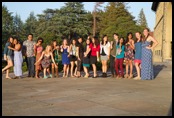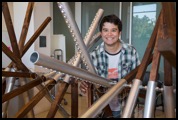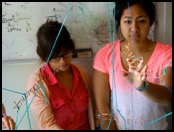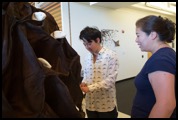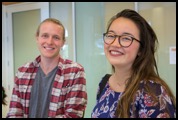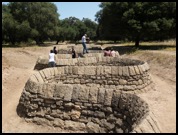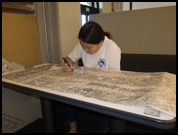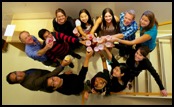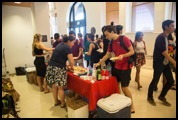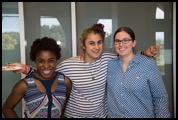TSR 2015-2016
Nineteen students exhibited TSR projects in the program’s sixth amazing year! The works included sculptural installations, graphic art, film, video, photography, painting and multimedia art, drawing, documentary film, stop motion film, memoir, poetry, fiction, a musical performance, and children’s fiction. The issues that the students considered included stress and resilience, health disparities, climate change, marine ecosystems, narcolepsy, depression, otherness, diabetes, medical anatomy, sense of place in nature, aging, environmental activism, L-form bacteria, moray eel anatomy, parasitoid wasps, fungal biology, cervical cancer, mental illness, HIV, the neuroscience of music, and safe childbirth.
TSR 2014-2015
Although we took a dip in terms of numbers, with twelve students finishing TSR projects in the program’s fifth year, the exhibition was electric. Student works included ilm, dance, sculpture, interactive installation, screenplay adaptation, drawings, memoir, and poetry. The issues and topics that the students considered included kelp forest ecosystems, drug use and abuse, animal intelligence, medical anatomy, anorexia, development of the polio vaccine, neuroscience of grief, mental vs physical health, epigenetics and inheritance, island ecosystems, emergent complexity, and social stereotypes about infectious disease.
TSR 2013-2014
We broke all records with twenty-two students finishing TSR projects in the program’s fourth fabulous year! Their works included photographs, documentary film, creative nonfiction, sculpture, aerial circus performance, shadow puppets, a graphic novel, spoken word, poetry, a rap video, graphic art, house music, audio podcast, and a stop motion film. The issues that the students considered included environmental degradation, diabetes, Alzheimer’s disease, pollution, pollinators, hepatitis B, whale conservation, neuroanatomy, neurophysiology, dyslexia, cystic fibrosis, neglected diseases, manic-depressive illness, links between health and the environment, child poverty, health disparities, human physiology, ecological webs, autism, evolution, and ants.
TSR 2012-2013
Seventeen students finished TSR projects in the program’s third year! Their works included documentary film, sculpture, watercolor paintings, a ceramic fountain, spoken word poetry, an improvisational jazz performance, digital art, paint on mirrors, a quilt, a novella, a photoessays, Indian classical dance, photography, and video art. The issues that the students considered included Alzheimer’s disease and memory, epilepsy, chronic illness, elephant conservation, the immune system and infection, polio, the water crisis, the science of food, schizophrenia, vision, children with special needs, breastfeeding, autism, death, mirror neurons and empathy, and biochemical enzymes.
TSR 2011-2012
We had 17 students finish TSR projects in our second year.Their works included sculpture, film, kinetic typography video, mixed media, street art, creative nonfiction, children’s books, audio documentary, mixed media and a sand art performance that explored the precarious position of frogs, the natural history of the California coastline, mutualism, schistosomiasis, the conservation of Oceanic white-tipped sharks, the skin, using animals in research, complexity from simplicity, valuation of the marine environment, Stanford’s ecology, human and environmental health, the laboratory mouse, neurochemistry and emotion, elephant communication, and public health.
The TSR Pioneers: 2010-2011
The Senior Reflection program was pioneered in 2010-2011 by nine students who collectively generated over thirty individual works of art. The pieces included documentary films, works of short fiction, photography, digital art, painting and drawing, and explored scientific themes that included the genetic modification of foods, human-animal conflict and habitat fragmentation, the mechanisms of rheumatoid arthritis, testing for genetic disease, our sense of touch, wilderness and equine medicine, and how new technologies are altering the art and science of breeding cattle.




